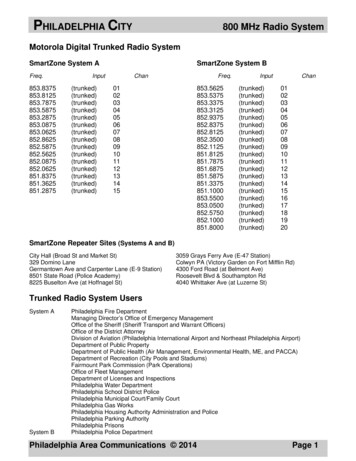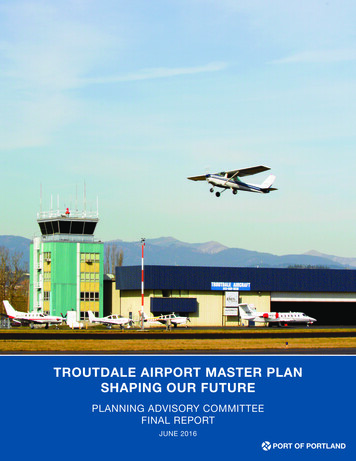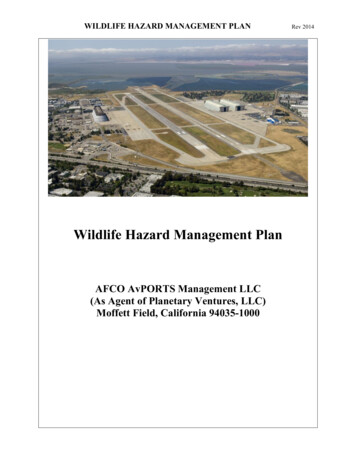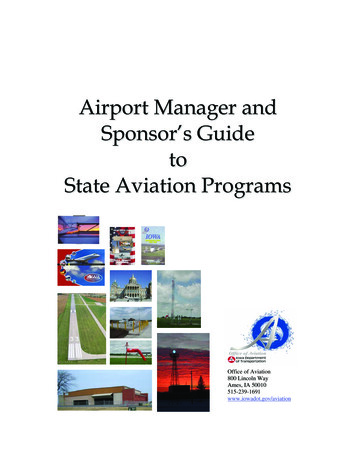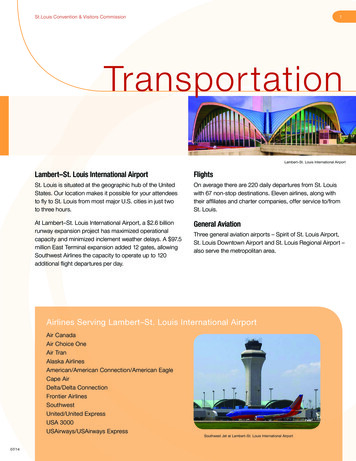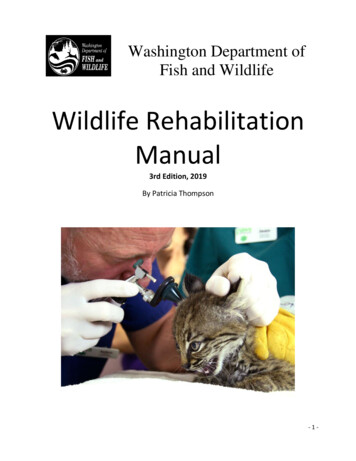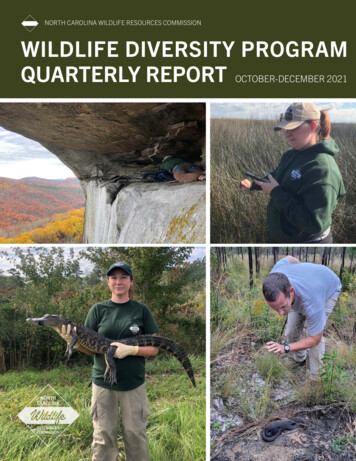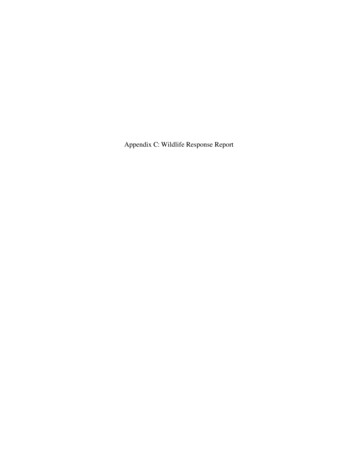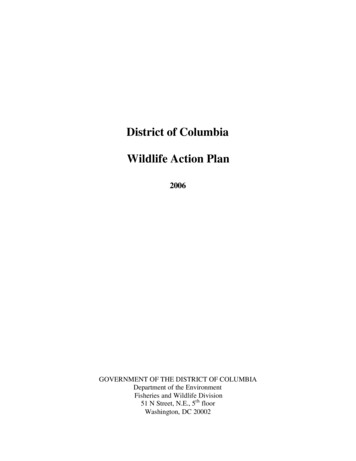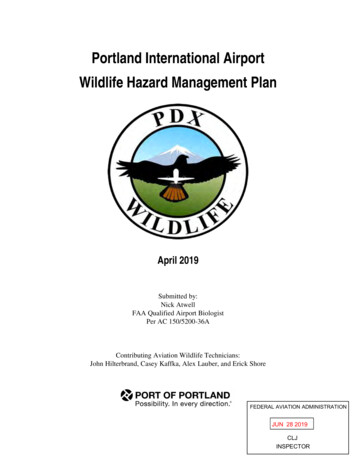
Transcription
Portland International AirportWildlife Hazard Management PlanApril 2019Submitted by:Nick AtwellFAA Qualified Airport BiologistPer AC 150/5200-36AContributing Aviation Wildlife Technicians:John Hilterbrand, Casey Kaffka, Alex Lauber, and Erick ShoreFEDERAL AVIATION ADMINISTRATIONJUN 28 2019CLJINSPECTOR
Intentionally left blankFEDERAL AVIATION ADMINISTRATIONJUN 28 2019CLJINSPECTOR
Plan ApprovalThe Portland International Airport developed this Wildlife Hazard Management Plan underthe direction of Nick Atwell, a Qualified Airport Wildlife Biologist as stipulated in FAAAdvisory Circular 150/5200-36A. The following Wildlife Hazard Management Plan forPortland International Airport has been reviewed and approved by the Airport OperationsManager and the Federal Aviation Administration. This plan will become effective on thesignature date.Airport Operations Manager(Printed Name)SignatureCharlotte JonesFederal Aviation Administration(Printed Name)Signature28 Jun 19DateFEDERAL AVIATION ADMINISTRATIONJUN 28 2019CLJINSPECTOR
Portland International Airport2019 Wildlife Hazard Management PlanAirport Certification Manual ReferenceThe PDX Wildlife Hazard Management Program is implemented by delegation ofauthority under the PDX Airport Certification Manual (ACM).The Port of Portland completed a Wildlife Hazard Management Plan (WHMP) forPortland International Airport (PDX) in 1998 to comply with 14 CFR Part 139.337. TheWHMP was subsequently updated in 2004 and again in 2009 to incorporate the findingsof the Port’s wildlife risk assessment process, account for changes to the WHMPinitiated in 2004, and to complete minor editorial corrections. This 2019 updateaddresses revised Federal Aviation Administration (FAA) regulations, integrates riskassessment information and includes program changes and editorial correctionsinstituted since 2009. These documents have been reviewed and approved by theAdministrator and his/her representative. These documents are located in the office ofthe General Manager of Operations & Maintenance and are hereby incorporated byreference into the ACM. The WHMP will be reviewed on a periodic basis to determinethe effectiveness of the program. Appropriate changes will be made as the need arises.This review will take place annually.FEDERAL AVIATION ADMINISTRATIONJUN 28 2019CLJINSPECTOR
Portland International Airport2019 Wildlife Hazard Management PlanTABLE OF CONTENTSEXECUTIVE SUMMARY . 11 INTRODUCTION . 11.1.Purpose and Application . 11.1.1.National Perspective . 11.1.2.Local Perspective . 21.1.3.WHMP Objective and Principles. 31.2.Wildlife Hazard Assessment [14 CFR 139.337] . 31.2.1.Wildlife Strikes . 41.2.2.Wildlife Species of Concern . 41.2.3.Wildlife Attractants . 6Food . 7Water . 7Shelter . 71.2.4.1.3.Baseline Conditions at PDX . 8WHMP Administration . 91.3.1.WHMP Review & Revision [14 CFR 139.337f (6)] . 91.3.2.FAA 14 CFR 139.337 Checklist. 91.3.3.Oregon Air National Guard BASH Plan . 112 PROGRAM ORGANIZATION, ROLES AND RESPONSIBILITIES [14 CFR 139.337f(1)] . 172.1.Program Organization . 172.2.Roles & Responsibilities of the Chief Operating Officer . 182.3.Roles & Responsibilities of PDX Wildlife Staff . 182.3.1.Sr. Natural Resources Manager . 182.3.2.FEDERAL AVIATION ADMINISTRATION 18Aviation Wildlife Manager .JUN 28 2019iCLJINSPECTOR
Portland International Airport2019 Wildlife Hazard Management Plan2.3.3.Wildlife Technicians . 202.3.4.Aviation Wildlife Student Position . 212.4. Roles & Responsibilities of Other Port Departments & OR ANG 142nd FighterWing 212.4.1.Other Port Departments . 21Airport Operations Manager. 21Airport Operations Supervisor (AOS) Responsibilities . 22Airport Maintenance Staff . 22Media Relations . 22Legal Administration . 232.4.2.OR ANG 142nd Fighter Wing . 23OR ANG Safety Officer . 23OR ANG Airfield Manager. 233 WILDLIFE MANAGEMENT STRATEGIES [14 CFR 139.337f (2)] . 253.1.Risk Evaluation Process. 253.2.Zone Concept . 263.2.1.Primary Zone . 273.2.2.Secondary Zone . 283.2.3.FAA Separation Zone. 283.3.Management Area Strategies . 373.4.General Operational Strategies . 433.5.Habitat Modification. 443.5.1.Port-Owned Property . 443.5.2.Non-Port Owned Property . 453.5.3.Water Management. 46Wetlands and other Waters of the U.S. . 47Standing Water and Poor Drainage . 47Storm Water Management Systems . 48FEDERAL AVIATION ADMINISTRATIONRunways, Taxiways, and Aprons .50iiJUN 28 2019CLJINSPECTOR
Portland International Airport3.5.4.2019 Wildlife Hazard Management PlanVegetation Management . 51Landscaping . 51Grass Management . 56Drainage Channel and Stream Side Vegetation. 58Agriculture . 593.5.5.Structure Management . 59Airport Improvement Projects and Airfield Buildings. 60Abandoned Structures . 61Airfield Structures . 61Physical Exclusion Devices . 613.5.6.Wildlife Food Source Management . 62Insects . 63Earthworms . 63Rodents and Rabbits . 64Trash and Debris . 65Food Handouts . 65Pesticides . 654 APPLICABLE LAWS, REGULATIONS, POLICIES & PERMITS [14 CFR 139.337f (3)]. 674.1.FAA Requirements . 674.1.1.Airport Grant Assurances . 674.1.2.14 CFR Part 139.337 . 684.2.National Environmental Policy Act . 694.3.Other Applicable Federal Regulations . 694.3.1.Clean Water Act, Section 404: . 694.3.2. Endangered Species Act (16 USC 1531-1543, Endangered Species Act of1973, As Amended) . 704.3.3.Migratory Bird Treaty Act. 714.3.4.Bald and Golden Eagle Protection Act . 714.3.5.Federal Insecticide, Fungicide, and Rodenticide Act . 71FEDERAL AVIATION ADMINISTRATIONJUN 28 2019iiiCLJINSPECTOR
Portland International Airport4.4.2019 Wildlife Hazard Management PlanState of Oregon Regulations . 724.4.1.Oregon Removal Fill Law . 724.4.2.Oregon Endangered Species Act . 724.4.3.Oregon Administrative Rules 635-43-0000 [Scientific Taking Permit] . 724.4.4. Oregon Administrative Rules 635-043-0051 to 0115 [Take or HarassWildlife Permit] . 724.4.5. Oregon Administrative Rules 837-012-0305 to 0370 [Pest ControlFireworks Permit] . 734.4.6.4.5.Statewide Planning Regulations . 73City of Portland Regulations . 734.5.1.City of Portland, Title 33, Planning and Zoning . 74Chapter 430, Environmental Zone Overlays . 74Chapter 33.565, Portland International Airport Plan District . 75City of Portland, Code 14A.60.020, Firearms Discharge . 754.6.Permits. 814.7.Port of Portland Missions, Goals & Policies . 834.7.1.Port Mission Statement . 83Aviation Mission Statement. 83Port of Portland Environmental Management System (EMS) . 83Port of Portland Environmental Policy (No.: 6.1.11) . 83Port of Portland Natural Resources Policy (No.: 7.4.11) . 844.7.2.Discussion of Port Policies . 845 RESOURCES TO IMPLEMENT THE PLAN [14 CFR 139.337f (4)] . 855.1.Wildlife Control Supplies . 855.2.Vehicles . 866 RISK MANAGEMENT PROCEDURES [14 CFR 139.337f (5)] . 876.1.Wildlife Control Procedures . 876.1.1.Personnel & Communications . 88FEDERAL AVIATION ADMINISTRATIONProtocol for AirfieldJUN 28 2019CLJINSPECTORAccess & Communications [14 CFR 139.337 (5iv)] . 88iv
Portland International Airport2019 Wildlife Hazard Management PlanCooperation with the Oregon Air National Guard Base BASH Program . 906.1.2.Hazing and Harassment . 90Pyrotechnic Devices . 90Remote Controlled Propane Sound Cannons . 91Other Auditory Frightening Devices . 91Visual Deterrents . 91Physical Harassment Devices . 92Protocol for Hazing Birds . 92OR ANG Protocol for Hazing Birds . 93Protocol for Management of Mammals . 946.1.3.Raptor Trapping & Translocation. 966.1.4.Avian Nest Intervention . 97Raptor Nests. 97Waterfowl Nests . 976.1.5.Lethal Action . 97GENERAL POLICY . 97European Starling Trapping Protocol . 1006.2.Research & Development . 1016.3.WHMP Information & Education . 1026.3.1.Internal Port Communication . 1026.3.2.External Audiences . 102Regulatory Agencies. 102Adjacent Landowners . 103General Public . 104Transfer of Technology . 1047 MONITORING, EVALUATION AND REPORTING [14 CFR 139.337f (7)] . 1077.1.Wildlife Monitoring and Data Collection . 1077.1.1.Wildlife Data Collection . 107Avian Point Count Surveys . 109Migratory Bird Surveys .FEDERAL AVIATION ADMINISTRATION 109vJUN 28 2019CLJINSPECTOR
Portland International Airport2019 Wildlife Hazard Management PlanStreaked Horned Lark Surveys . 1097.1.2.7.2.Wildlife Strikes . 110Project Evaluation . 1107.2.1.Project Screening for Proposed Development . 1107.2.2.Monitoring and Evaluations . 1117.3.Annual Review and Reporting . 1128 WILDLIFE STAFF TRAINING REQUIREMENTS [14 CFR 139.337f (7)] . 1159 LITERATURE CITED. 117AppendicesAPPENDIX ATable of Revisions 2009 to 2019APPENDIX BWildlife Risk Evaluation ModelAPPENDIX CPrioritized List of Actions TablesAPPENDIX D14 CFR Part 139.337. Certification of Operations: Land AirportsServing Certain Carriers: Wildlife Hazard ManagementAPPENDIX E142nd Fighter Wing, Oregon Air National Guard Bird Aircraft StrikeHazard (BASH) Plan 91-212APPENDIX FAirport Plant ListAPPENDIX GPDX Wildlife Deterrent FencingAPPENDIX HAvian Point Count ProtocolFEDERAL AVIATION ADMINISTRATIONJUN 28 2019viCLJINSPECTOR
Portland International Airport2019 Wildlife Hazard Management PlanList of FiguresFigure 1. Portland International Airport Vicinity Map . 13Figure 2. Portland International Airport Facilities Map. . 15Figure 3. Port Wildlife Management Program organization effective 01/01/2019. . 17Figure 4. Primary Zone. 31Figure 5. Secondary Zone . 33Figure 6. FAA Separation Zone . 35Figure 7. Location of wildlife management areas around PDX . 41Figure 8. Overlapping crown structures that allow birds to move safely from tree to treewithout exposure to predators or weather. 54Figure 9. An example of a tree species that is attractive to birds because of its horizontalbranching structure. 55Figure 10. An example of an ideal tree type for landscaping at PDX because it hasminimal opportunities for perching and nesting due to its vertical branching structure. . 55Figure 11. Conceptual landscaping design for the Secondary Zone that demonstratesdiscontinuous crown closure at both a vertical and horizontal scale. . 56Figure 12. City of Portland Designated Environmental Zones in the Vicinity of PortlandInternational Airport . 77Figure 13. Airport Plan District . 79Figure 14. Lethal action decision flowchart . 100List of TablesTable 1. Current list of wildlife species of concern and monitor species for PDX based onthe Risk Assessment Model and data from 01/01/13-12/31/17 . 6Table 2. Aviation Grass Seed Specification. . 57Table 3. Various federal, state, and local permits acquired for wildlife hazardmanagement practices at PDX. . 81FEDERAL AVIATION ADMINISTRATIONTable 4. PDX Wildlife Hazard Management program training requirements . 115JUN 28 2019viiCLJINSPECTOR
Portland International Airport2019 Wildlife Hazard Management PlanACRONYMSAC – FAA Advisory CircularACM – Airport Certification ManualAF1 – Airfield 1AFI – Air Force InstructionAFPAM – Air Force PamphletAGL – Above Ground LevelATCT – Air Traffic Control TowerATIS – Automatic Terminal Information ServiceAOA – Air Operations AreaAOS – Airport Operations SupervisorBATS – Business Analysis and Term Sheet ProceduresBASH – Bird Aircraft Strike HazardCFR – Code of Federal RegulationCUMP – Conditional Use Master PlanCWA – Clean Water ActDEQ – Oregon Department of Environmental QualityEA – Environmental AssessmentEC – Environmental Conservation ZoneEISEnvironmental Impact StatementEMS – Environmental management systemEP – Environmental Protection ZoneEPA – U.S. Environmental Protection AgencyESAEndangered Species ActFAA – Federal Aviation AdministrationFEDERAL AVIATION ADMINISTRATIONFAR – Federal Aviation RegulationsviiiJUN 28 2019CLJINSPECTOR
Portland International Airport2019 Wildlife Hazard Management PlanFOD – Foreign Object or DebrisFONSI – Finding of No Significant ImpactHCPHabitat Conservation PlanIAW – Air Force InstructionITPIncidental Take PermitMBTA – Migratory Bird Treaty ActMCDD – Multnomah County Drainage DistrictMOC – Maintenance Operations CenterNEPA – National Environmental Policy ActNOAA – National Oceanic Atmospheric AdministrationNRI – Natural Resources InventoryOAR – Oregon Administrative RulesODFW – Oregon Department of Fish and WildlifeODSL – Oregon Division of State LandsOI – Operating InstructionOR ANG – Oregon Air National GuardORS – Oregon Revised StatuesPDX – Portland International AirportPIA – Portland International Airport (OR ANG reference to PDX)PIC – Portland International CenterPort – Portland of PortlandRPZ – Runway Protection ZoneSHLA Streaked Horned LarkTSA – Transportation Security AdministrationUSACE – US Army Corps of EngineersUSAF – U.S. Air ForceFEDERAL AVIATION ADMINISTRATIONixJUN 28 2019CLJINSPECTOR
Portland International Airport2019 Wildlife Hazard Management PlanUSDI – U.S. Department of the InteriorUSFWS – U.S. Fish and Wildlife ServiceWDFW – Washington Department of Fish and WildlifeWHMP – Wildlife Hazard Management PlanWIS – Wildlife Information SystemFEDERAL AVIATION ADMINISTRATIONJUN 28 2019xCLJINSPECTOR
Portland International Airport2019 Wildlife Hazard Management PlanEXECUTIVE SUMMARYPORTLAND INTERNATIONAL AIRPORT WILDLIFEHAZARD MANAGEMENT PLAN 20191.0INTRODUCTIONThe first Wildlife Hazard Management Plan (WHMP) was developed in 1998 for PortlandInternational Airport (PDX) in response to identified wildlife hazards on and around theairfield. Since the initial WHMP was developed, it has been revised over the years toreflect changes in program organization, administration, and implementation. This 2019version of the plan addresses revised regulations, incorporates other changes madewithin the program, and includes editorial corrections from the previous version. A tableof revisions from 2009 to 2019 is included as Appendix A.Nationally, wildlife present hazards to safe aircraft operations and, in rare cases, havecaused catastrophic events resulting in the loss of human lives. Although the potentialfor this type of event is very low, the concern is very real. Additionally, wildlife strikes cancause damage to aircraft and impact airport operations, which cost the industryhundreds of millions of dollars, and hundreds of thousands of hours of aircraft down timeevery year. The Federal Aviation Administration (FAA) recognizes these potentialhazards and directs FAA regulated airports that experience one or more triggeringevents to perform a Wildlife Hazard Assessment (WHA) and possibly develop/implementa WHMP in accordance with 14 CFR Part 139.337. The triggering events are as follows:(1) An air carrier aircraft experiences multiple wildlife strikes;(2) An air carrier aircraft experiences substantial damage from striking wildlife;(3) An air carrier aircraft experiences an engine ingestion of wildlife; or(4) Wildlife of a size, or in numbers, capable of causing an event is observed to haveaccess to any airport flight pattern or aircraft movement area.Prior to the development of the WHMP, the Port of Portland (Port) completed an initialWHA in 1996 to establish baseline information on wildlife and habitats at PDX. PacificHabitat Services completed a second WHA in 2001 preparatory to the drafting of therevised PDX WHMP in 2002-03. A third WHA and WHMP was prepared by Jones &Stokes in 2003 and 2004. Since then, PDX Wildlife Staff continue to document wildlifepresence and behavior on and around the airfield as an ongoing hazard assessment toguide management actions. This collection of data provides a way to track wildlife strikesand establish a list of wildlife species of concern as well as the most used attractants onand around the airfield.This plan satisfies the requirements set forth in FAA 14 CFR 139.337 and is reviewed atleast annually, or whenever an air carrier aircraft experiences a triggering event thatwould warrant an additional review. This review/revision protocol will ensure that theWHMP stays current and responsive to changing conditions, and incorporates theprinciples of adaptive management. An annual report is prepared and submitted to theFEDERAL AVIATION ADMINISTRATIONE1JUN 28 2019CLJINSPECTOR
Portland International Airport2019 Wildlife Hazard Management PlanFAA to inform the annual Part 139 certification inspection, and serves as an annualprogram review and ongoing WHA. A checklist of the FAA requirements that this planincludes is provided, along with where each item can be found in the plan.2.0PROGRAM ORGANIZATION, ROLES AND RESPONSIBILITIESThis chapter details the organizational structure of the Wildlife Hazard ManagementProgram and the roles and responsibilities of those individuals with a direct role in itsimplementation. The Wildlife Hazard Management Program exists within the Port’sEnvironmental Operations Department and has many points of interaction with otherinternal and external stakeholders. The Port’s Chief Operating Officer retains theultimate decision-making authority for major program decisions. The Aviation WildlifeManager directs personnel and activities related to wildlife hazard management andreports to the Sr. Natural Resources Manager and the Environmental OperationsDirector.The Port recognizes that the cooperation of many departments both inside, and outside,of the Port is necessary for the successful implementation of the WHMP. This chapteralso includes a detailed description of the roles and responsibilities of the Ports AirportOperations, Maintenance, Media Relations, and Legal Administration departments,along with the OR ANG 142nd Fighter Wing.3.0WILDLIFE MANAGEMENT STRATEGIESChapter 3 details the risk evaluation process and model developed by the Port todetermine which wildlife species are of the most concern to aviation safety. Data for themodel is obtained from two sources: the United States National Strike Database anddocumented PDX wildlife data. National Strike data is used for determining the severityof impact while the local PDX wildlife data is used to determine a species probability ofoccurrence. Using both datasets, each species is assigned a risk category for both theirpotential severity of impact as well as their probability of occurrence. The results of therisk model are implemented based on the varying management areas on and aroundPDX. Using a tiered approach, the Port has established three separate zones within theFAA’s 10,000-foot separation distance. These zones are the Primary Zone, SecondaryZone, and FAA Separation Zone and are used to prioritize m
APPENDIX E 142nd Fighter Wing, Oregon Air National Guard Bird Aircraft Strike Hazard (BASH) Plan 91-212 APPENDIX F Airport Plant List APPENDIX G PDX Wildlife Deterrent Fencing APPENDIX H Avian Point Count Protocol FEDERAL AVIATION ADMINISTRATION CLJ INSPECTOR JUN 28 2019

